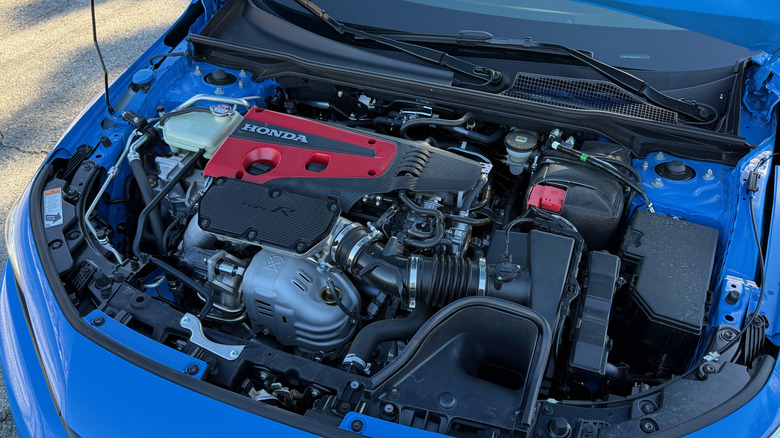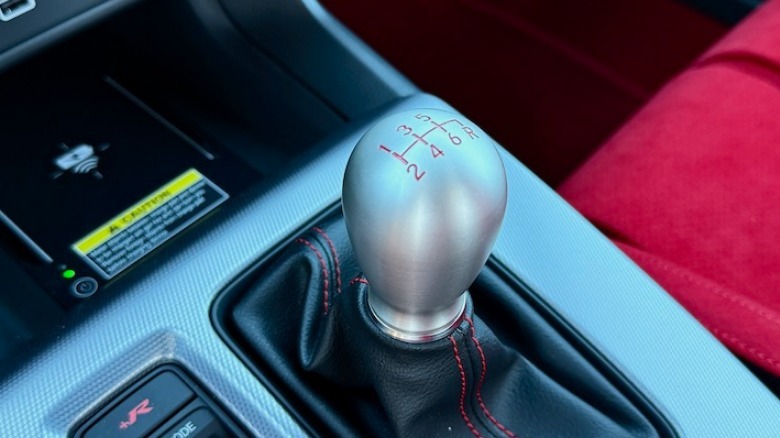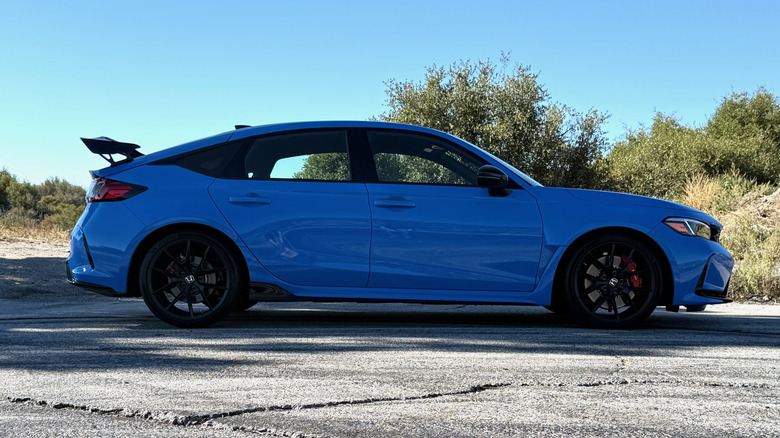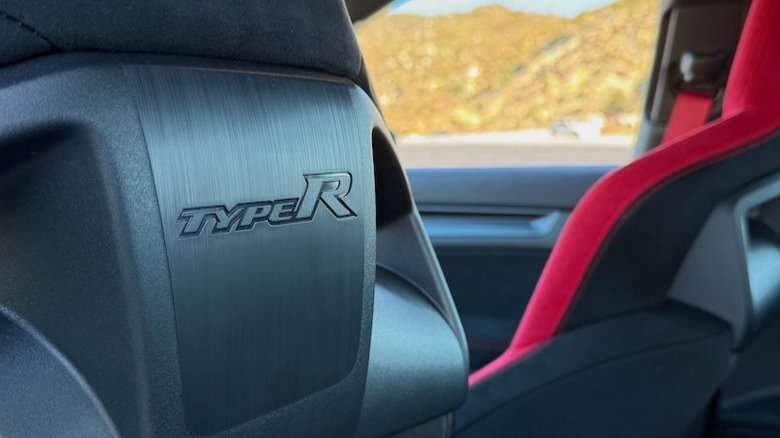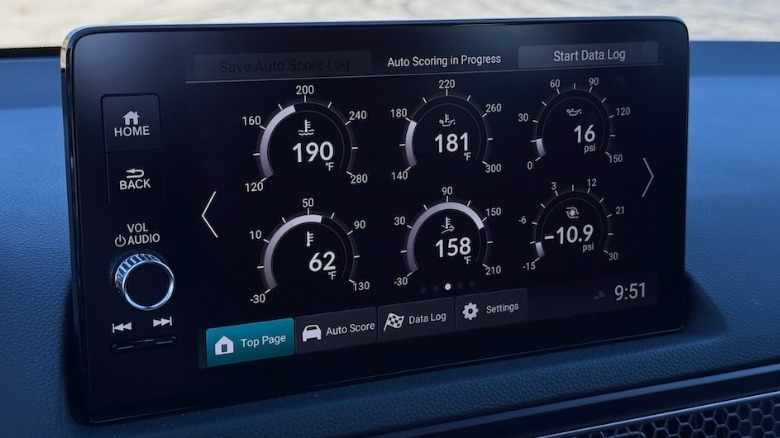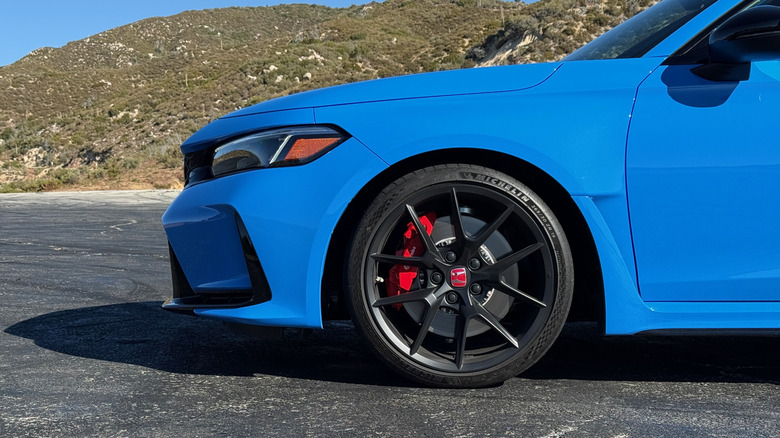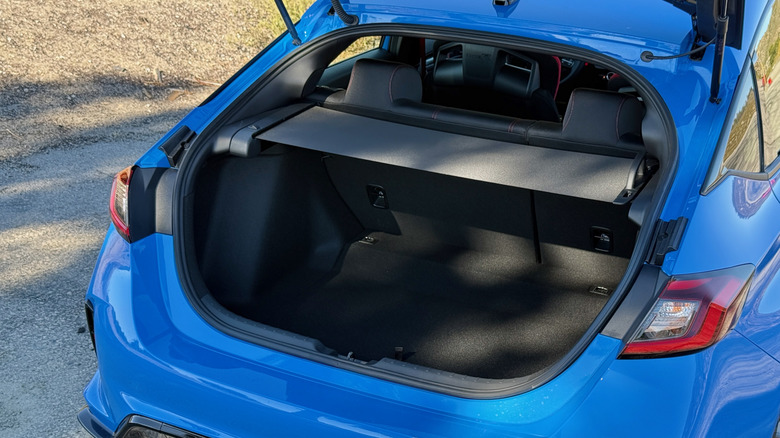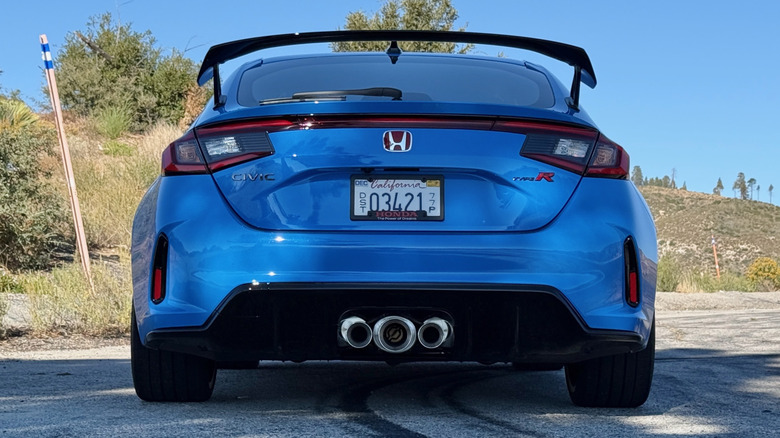The Honda Civic Type R Isn't Cheap, But It's Still A Bargain
The Honda Civic Type R was once forbidden fruit. It was the stuff of JDM legends and the car community here in the United States never had access to it. We saw pictures in magazines, watched videos from Europe and Japan, but going into a dealership and buying a Type R wasn't in the cards. Then came the FK8.
The 2017 Honda Civic Type R was America's first bite at the bright red Type-R apple. The styling had boy-racer/stormtrooper vibes and lots of aggressive bodywork, but even when SlashGear reviewed it back in 2017, we knew the Type R was special. Today, a much more grown up and refined version of the Type R is on the market. It's just as practical and almost as ubiquitous as the standard Civic, but way more fun.
The 2025 Civic Type R is part of the FL5 generation and it might be grown up, but it's certainly not subtle about its performance intentions. The interior is bright red, there's a giant wing on the back, and three big exhaust tips that scream "Look at me! I'm a Type R!" Just like all the 90s kids hoped for, the current Civic Type R is engaging, fun to drive, and it stands out in a crowd. It's been a few years since Honda introduced this generation of Type R (the second in the US), so you'd be justified in thinking the shine had faded a little bit, but this hot hatch continues to exceed expectations.
A stalwart source of power
The Type R's powerplant, the steadfast Honda K Series engine, has been around for over two decades, providing all sorts of power to all sorts of Honda and Acura products. Under the hood of the 2025 Civic Type R, lives the latest version: a turbocharged 2.0-liter inline-four that produces 315 horsepower and 310 lb-ft of torque. It's paired exclusively with a six-speed manual transmission with rev matching, a limited-slip differential, and — of course — the Type R is front-wheel drive.
Moving through corners at speed and giving the Type R a heavy dose of throttle, you can feel the limited-slip differential clawing its way forward, like it's begging for more road to be put in front of it. For a front-wheel-drive car, it's about as entertaining as it gets. Climbing up through the gears was a rewarding experience too. The Type R's clutch pedal is light and the lever slides in and out of gears with ease.
The shifter itself felt excellent in my hand. It's substantial and well-weighted like you'd expect from a performance product with an even larger price tag. Letting the Type R do the rev-matching for you as you downshift is a perfectly acceptable way to drive it, but the pedal box is properly sized and situated so a bit of heel-toe driving is just as easy and rewarding too. It's one of the best manual transmissions you can currently buy, at any price point.
It puts a smile on your face, every time
As you'd probably expect from a car with a bunch of Nürburgring lap records, the Type R has impressive handling capabilities. The Michelin Pilot Sport 4S tires barely squealed or begged for any attention, even with some pretty aggressive maneuvers on my part. The Type R is large enough to feel stable in high-speed corners, but small enough to feel deft during the tighter ones. The steering is about as good as it gets too. It's well-weighted, responsive, and feels directly connected to the action. It's extremely easy to pick a spot on the road, aim for it with the steering wheel, and hit your mark with either of the front tires.
Head for a corner with a bit too much speed and you'll be getting plenty of brake feedback from the middle pedal and more than enough stopping power from the Brembo four-piston front brakes. The Type R is the most powerful Civic, but it also drives in a way which puts it ahead of any other Civic, including the engaging and entertaining Civic Si.
Just enough comfort, but not too much
The Type R occupies an interesting space. On top of having the sporty Si to compete with, the Type R shares a platform and an engine with the excellent Acura Integra Type S. With the Integra Type S priced slightly higher and offering a bit more comfort, the Civic Type R has to be the more-aggressive of the platform twins. So, the Type R uses the same adaptive suspension dampers as the Integra, but with more aggressive tuning. Even in the Type R's comfort setting, things are a little bit stiffer than in the Type S, and as a result the Civic feels a bit rough over broken city streets.
Going over sharp road imperfections like cracks or bumps, impacts make their way into the cabin. There's a little bounce and jostle from underneath, but things settle down quickly and happily it's not enough to upset the chassis at speed, even going through corners with a hustled pace. This stability gave me a ton of confidence in the Type R. The seats are properly bolstered for high-performance driving and they'd work great for holding you in place around any racetrack, but they're a bit on the firm side too. After hours behind the wheel, I wasn't exactly sore, but I wasn't bathed in a glow of comfort either. The Type R is a performance machine that's also practical, not the other way around.
It's not cheap, but it's worth it
With so many different variations available, the Civic's price range is pretty wide. Base models of the sedan start around $25k, with the 2025 hatchback coming in at $28,600 (including $1,150 destination fee). [A quick note: 2026 pricing has been announced for the standard Civic but not the Type R yet. And, since the Type R we tested was a 2025 model, we're going to use the 2025 prices here. 2026 Hatchback models are $390 more across the board.]
Upgrade to the Civic Sport Hybrid and that price goes up to $31,300, with the Sport Touring Hybrid adding another $3,000. The standard Civic Si will run you $31,400 and summer tires will cost you another $300 on top.
Then there's the Type R, towering over them all with an MSRP of $47,045 (plus the $455 for Boost Blue exterior paint). It's special, and there's a lot to like about the way it drives, but that's more than $15,000 greater than the price of any other Civic. Thankfully, the Type R is an as-it-is sort of deal, packing in all the features and leaving little available in terms of options or large upgrade packages. There are a few accessory packages which include features like a carbon fiber spoiler or upgraded wheels, but most of the other equipment comes standard.
So what's standard?
On top of its engine upgrade and the excellent fit-and-finish we're accustomed to from high-end Hondas, the Type R gets a lot of unique hardware and software to enhance its performance. Adaptive dampers, big brakes, and 19-inch wheels (standard hatchback Civics and Si's get 18's) all underpin the Type R, while the sticky Michelin tires give it grip. The Pilot Sport 4S tires are a bit noisy on the highway, but it's worth the trade-off.
Where the standard Civic and the Civic Si get three drive modes, the Type R gets a fourth for direct access to peak performance: +R. It also gets Honda's LogR performance datalogger system for keeping track of important stats on track days.
For more everyday activities, the Type R also gets a lot of standard driver aids like adaptive cruise control, lane-keep assist, lane-departure warning, forward collision warning, and blind-spot monitoring. The adaptive cruise control was a bit too sensitive for the hustled pace of Los Angeles traffic, so I left it turned off for most of my test, but on the open highway it works pretty well. Dual-zone automatic climate control is standard, but the Type R's bucket seats don't get a heating function.
Lots of standard tech, but a few glitches
A 10.2-inch driver display takes care of the gauges while a 9-inch center touchscreen has the infotainment interface handled. Wireless Apple CarPlay and Android Auto are standard on the Type R, as are a pair of USB-A ports (the Type R hasn't switched to USB-C just yet, even though its Civic-siblings have). A 12-speaker Bose sound system comes standard in the Type R, with enough volume and clarity for most drivers, but audiophiles may find themselves upgrading to something with a bit more power and volume capacity.
The tech, while mostly in working order over my week with the Type R, did falter from time to time. The Civic's connection with Apple CarPlay was severed more than once, with no discernible reason. The system would eventually reconnect but this happened two or three times over a week. I could see it being an annoying issue for owners, but I wouldn't go so far as to call it a dealbreaker. Another small issue I had involved the tire pressure monitoring sensors. The car displayed an error in the TMPS system that had me manually checking pressures roadside, which took a few minutes (they were fine), then I had to reset the system. Thankfully, it only occurred once over my week with the Type R.
It's still a spacious hatchback
Like its standard-hatchback brethren, the Type R has a spacious interior. The number of seats is reduced from five to four (there's no middle seat in the rear of a Type R, just a few cupholders), but there's plenty of legroom, headroom, and shoulder room for adults in all four seating positions. Behind the rear seats there's 24.5 feet of cargo space which is plenty spacious for all your luggage. And aesthetically, a bright red interior is the perfect fit for a car like the Type R. It's bold enough for the race car image, but the color is executed well enough — and without covering all the interior surfaces — that it still feels premium. That's part of what makes the practicality feel premium.
Another point for the Civic in the practicality department: it has excellent outward visibility in basically every direction. The dashboard is low and easy to see over and the windows and rearview mirrors are large. Even the big rear wing doesn't get in the way of visibility, at least not in my preferred seating position. From where I set up the seat and the rearview mirrors I could see right under the wing through the mirror towards traffic in the rear.
Honda Civic Type R Verdict
The biggest drawback of the Civic Type R is its sizable price tag, but it does a lot of hard work to justify the premium over the standard model. The excellent K Series engine is an icon we'll miss when it's gone. Handling characteristics, comfort levels, and practicality are all right at the top of the class. The Toyota GR Corolla is certainly a rowdy and worthy rival to the Type R, priced similarly and packing a similar punch, but the Toyota is smaller with less cargo space and significantly less rear legroom. The Volkswagen Golf GTI is another option, but it lacks the power to keep up with the Type R. A Ford Mustang GT Premium can be had for around the same price as the Type R or GR Corolla, but if you're looking for a realistic four-seater, it won't get the job done.
SlashGear's Chris Davies contends that you don't need the Type R, the Si will do just fine, and I'm inclined to agree, especially when you consider that he's my boss compare the prices of the two Civics and their overlapping skill sets. They're extremely similar in many ways and they use a lot of identical mechanical parts to achieve their high levels of engagement. Still, every time I drove the Type R, I was reminded just how special it is.
Post Script: counting the Type R logos
This is slowly becoming one of my favorite parts of reviewing high-performance cars. In my Cadillac CT5-V Blackwing review and in my test week with the Ford Expedition King Ranch, I counted logos to see just how proud the automakers were of their specialized brand names. Since a lot of enthusiasts in the Honda community (myself included) are known for generously slapping badges on their cars, I figured the Type R was the perfect candidate for this sort of cross-platform judgement.
Naturally, the Type R had one logo on the trunk, another on the front grille. On the inside, each of the front seats had the Type R logo on both the front and back. Add those four to the mix and we're at six, total. A numbered dashboard placard takes that to seven, and an engine-bay logo brings it up to eight. And that's it for non-digital logos. Honestly, the Civic is kinda slacking when it comes to logos. The brakes simply rear "Brembo" and the wheels get a nice red "H" center cap, but no Type-R-specific logos to speak of. Oh well. I guess that just gives owners the opportunity to add a few of their own wherever they please.


